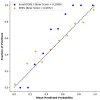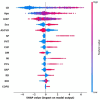Machine learning-based hybrid risk estimation system (ERES) in cardiac surgery: Supplementary insights from the ASA score analysis
- PMID: 40549810
- PMCID: PMC12184902
- DOI: 10.1371/journal.pdig.0000889
Machine learning-based hybrid risk estimation system (ERES) in cardiac surgery: Supplementary insights from the ASA score analysis
Abstract
Accurate prediction of postoperative mortality risk after cardiac surgery is essential to improve patient outcomes. Traditional models, such as EuroSCORE I, often struggle to capture the complex interactions among clinical variables, leading to suboptimal performance in specific populations. In this study, we developed and validated the Ensemble-Based Risk Estimation System (ERES), a machine learning model designed to enhance mortality prediction in patients undergoing coronary artery bypass grafting and/or valve surgery. A retrospective analysis of 543 patients was performed using six machine learning algorithms applied to preoperative clinical data to assess predictive accuracy and clinical outcomes. Feature selection techniques, including Gini importance, Recursive Feature Elimination, and Adaptive Synthetic Sampling, were employed to improve accuracy and address class imbalance. ERES, which utilizes 15 key features, demonstrated superior predictive performance compared to EuroSCORE I. Calibration plots indicated more accurate probability estimates, whereas SHAP analysis identified creatinine, age, and left ventricular ejection fraction as the most significant predictors. The decision curve analysis further confirmed the superior clinical utility of ERES across a range of decision thresholds. Additionally, although the American Society of Anesthesiologists (ASA PS) score had limited predictive power independently, its combination with EuroSCORE I enhanced the predictive performance. Integrating machine learning models like ERES into clinical practice can improve decision making and patient outcomes although external validation is warranted for broader implementation.
Copyright: © 2025 Birlik et al. This is an open access article distributed under the terms of the Creative Commons Attribution License, which permits unrestricted use, distribution, and reproduction in any medium, provided the original author and source are credited.
Conflict of interest statement
The authors have declared that no competing interests exist.
Figures









Similar articles
-
The comparative and added prognostic value of biomarkers to the Revised Cardiac Risk Index for preoperative prediction of major adverse cardiac events and all-cause mortality in patients who undergo noncardiac surgery.Cochrane Database Syst Rev. 2021 Dec 21;12(12):CD013139. doi: 10.1002/14651858.CD013139.pub2. Cochrane Database Syst Rev. 2021. PMID: 34931303 Free PMC article.
-
Impact of residual disease as a prognostic factor for survival in women with advanced epithelial ovarian cancer after primary surgery.Cochrane Database Syst Rev. 2022 Sep 26;9(9):CD015048. doi: 10.1002/14651858.CD015048.pub2. Cochrane Database Syst Rev. 2022. PMID: 36161421 Free PMC article.
-
Drugs for preventing postoperative nausea and vomiting in adults after general anaesthesia: a network meta-analysis.Cochrane Database Syst Rev. 2020 Oct 19;10(10):CD012859. doi: 10.1002/14651858.CD012859.pub2. Cochrane Database Syst Rev. 2020. PMID: 33075160 Free PMC article.
-
Cost-effectiveness of using prognostic information to select women with breast cancer for adjuvant systemic therapy.Health Technol Assess. 2006 Sep;10(34):iii-iv, ix-xi, 1-204. doi: 10.3310/hta10340. Health Technol Assess. 2006. PMID: 16959170
-
Predicting 30-Day Postoperative Mortality and American Society of Anesthesiologists Physical Status Using Retrieval-Augmented Large Language Models: Development and Validation Study.J Med Internet Res. 2025 Jun 3;27:e75052. doi: 10.2196/75052. J Med Internet Res. 2025. PMID: 40460423 Free PMC article.
References
-
- Roques F, Nashef SA, Michel P, Gauducheau E, de Vincentiis C, Baudet E, et al. Risk factors and outcome in European cardiac surgery: analysis of the EuroSCORE multinational database of 19030 patients. Eur J Cardiothorac Surg. 1999;15(6):816–22; discussion 822-3. doi: 10.1016/s1010-7940(99)00106-2 - DOI - PubMed
LinkOut - more resources
Full Text Sources
